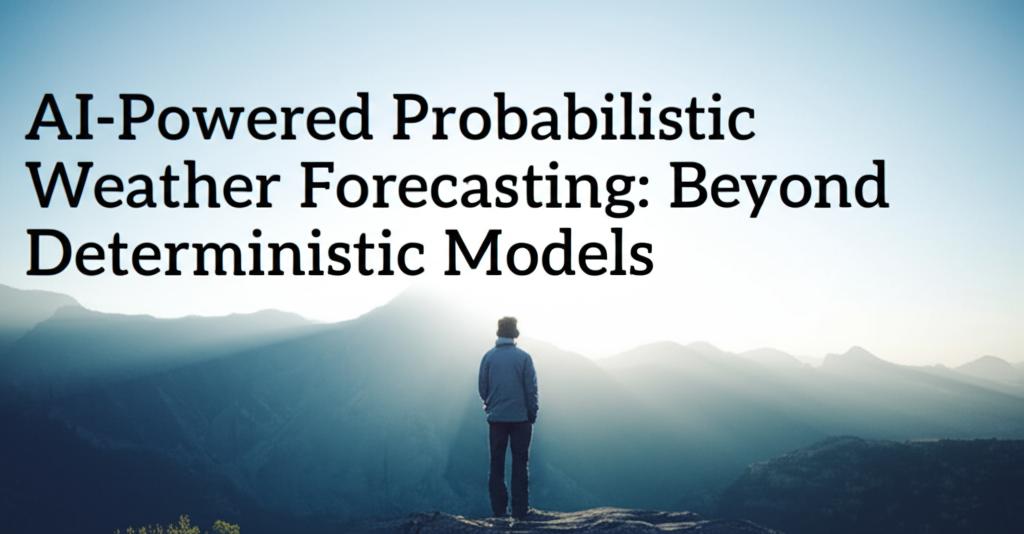The landscape of weather forecasting is undergoing a significant transformation, moving beyond traditional deterministic models towards AI-powered probabilistic approaches. This shift promises to provide more comprehensive and actionable weather information.
Deterministic weather models, which provide a single "best guess" forecast, are increasingly being recognized as limited due to the inherent chaos and uncertainty in atmospheric systems. Small errors in initial conditions can lead to vastly different outcomes, a concept popularly known as the "butterfly effect". This makes single-point forecasts less reliable, especially when predicting extreme weather events where understanding the range of possibilities is crucial.
AI, particularly machine learning, is revolutionizing this field by enabling the development of sophisticated probabilistic forecasting systems. These systems generate an ensemble of forecasts, each representing a possible future weather scenario. This approach provides a more complete picture of potential weather conditions and their likelihood, allowing for better risk assessment and decision-making.
Companies like Google DeepMind are at the forefront of this innovation with models like GenCast. GenCast is an AI ensemble model that can generate numerous possible weather trajectories, offering predictions up to 15 days in advance. It has demonstrated the ability to outperform leading operational systems in forecasting both everyday weather and extreme events. Another Google innovation, SEEDS (Scalable Ensemble Envelope Diffusion Sampler), leverages generative AI to efficiently create large ensembles of weather forecasts at a fraction of the computational cost of traditional methods. This allows for better characterization of rare and extreme weather events.
The European Centre for Medium-Range Weather Forecasts (ECMWF) is also embracing AI, with projects like its WeatherGenerator, indicating a clear move towards AI-driven ensemble models as the future of weather forecasting. Their AI forecasting system (AIFS) has already shown promising results, even surpassing some earlier AI models in accuracy for certain parameters.
Benefits of AI-Powered Probabilistic Forecasting:- Improved Accuracy and Longer Lead Times: AI models can process vast amounts of historical and real-time data from various sources like satellites, weather stations, and radar, leading to more accurate forecasts and earlier warnings for severe weather.
- Enhanced Understanding of Uncertainty: Probabilistic forecasts quantify the uncertainty associated with predictions, providing a range of possible outcomes and their likelihood. This is critical for risk assessment and decision-making in various sectors like energy, agriculture, and emergency management.
- Better Prediction of Extreme Events: AI ensembles are showing promise in more accurately predicting the likelihood and intensity of extreme weather phenomena like hurricanes, heatwaves, and floods.
- Increased Efficiency: AI can automate data processing and forecast generation, freeing up human forecasters to focus on interpretation, communication, and research.
- Cost-Effectiveness: AI models can be more cost-effective to run compared to traditional, computationally intensive numerical weather prediction (NWP) models.
Despite the significant advancements, challenges remain. The quality and availability of large, high-quality datasets for training AI models are crucial. Data gaps, inconsistencies, and biases in historical data can limit the performance of AI models. Ensuring that AI models can accurately represent the complex physics of weather systems is another ongoing area of research.
The future of weather forecasting likely lies in hybrid approaches that combine the strengths of AI with traditional physics-based NWP models. Efforts are also underway to improve the resolution of AI forecasts and their ability to predict localized phenomena and specific challenges like precipitation. Furthermore, making AI models more explainable (Explainable AI or XAI) is important for building trust and enabling forecasters to understand how predictions are derived.
The integration of AI into probabilistic weather forecasting marks a paradigm shift, offering the potential for more accurate, reliable, and actionable weather information to navigate an increasingly complex and climate-impacted world.

